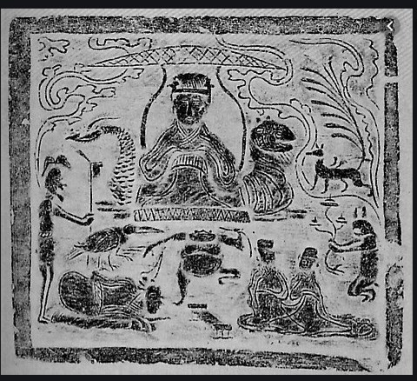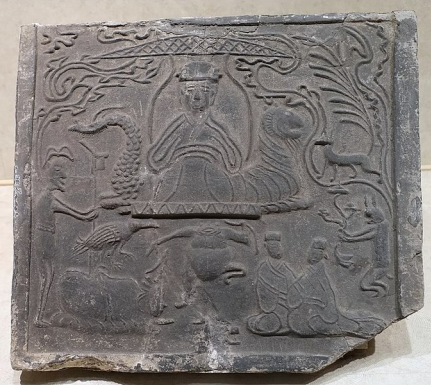5.1: The Queen Mother of the West
- Page ID
- 135118
The Queen Mother of the West 西王母 was an old and high-profile god, but only one of a large and ever-growing Daoist pantheon, or hierarchy of gods, in Han times. That she was called a “monarch” or 王 could mean “spiritually powerful” or just “one of the gods.”1 Shang oracle bones refer to deities called Western Mother and Eastern Mother. By the time of Confucius and Laozi, there were various figures called Queen Mother of the West: a teacher, a directional deity, some mountain spirits, a divine weaver, a shaman, and a star god. Probably each of these was a different local cult, and it was Daoism that brought them all together. The Zhuangzi lists her as a “Great Instructor,” said to have attained the Way and to be seated on a mythical Western mountain.
The Classic of Mountains and Seas, with texts on geography, ethnography, and myth dating back to 400 BC, but compiled by the Han scholar Liu Xiang, says:
To the west is a mountain called Jade Mountain. This is the place where the Queen Mother of the West dwells. Her appearance is like that of a human, with a leopard’s tail and tiger’s teeth. Moreover, she is skilled at whistling. In her disheveled hair she wears a sheng headdress. She presides over the constellations “Grindstone” and “the Five Sherds” or “Five Destructive Forces.”
How should we understand this? The headdress may represent part of a loom or a crown of stars, or it may have been adopted from images of the Syrian goddess Kybele, who also sits facing front, seated on a throne entwined with animal figures, and wearing a curious headdress, and who is portrayed on coins from Kushan, in modern Afghanistan. Whistling represents Daoist breath control. Her hair is disheveled because of the ecstatic dance of her shamanic communion between humans and spirits, and her body or costume include a leopard’s tail and tiger’s teeth, a shaman’s costume representing the ability to change into or be like a powerful animal.
Organized Daoism tamed the Queen Mother of the West during the Han period, bringing her ancient and imported characteristics together with local cults. This Daoist Queen Mother of the West was associated with yin, appeared to humans, and ruled over a western paradise, while keeping her headdress and shamanist associations. Pictures show her being served food by birds and attended by nine-tailed foxes, a white hare with a mortar and pestle for pounding an immortality elixir, a dancing frog, a three-legged crow, a tall figure holding a halberd, and sometimes with the primordial serpent-tailed brother and sister Fuxi and Nuwa.
The contradictions never had to be resolved. The very fact that the tradition had so many elements allowed it to appeal to all kinds of people. As one art historian puts it, the Queen Mother of the West “was both of and beyond this world; she lived in lands west of the Chinese Empire yet symbolized the delights of everlasting life in an otherworldly realm of immortality, the ideal afterlife pursued by the people of the Han.”2 Wudi worshipped her, and tried to attract Daoist transcendents from her paradise by constructing high buildings and an earthly paradise including a lake converted from its purpose of training the navy to sail multi-storied ships.3


Wealthy families worshipped her on altars, and wishing to enter her Western Paradise had workmen put her on their coffins and tombs, bronze mirrors and roof tiles. There she was portrayed with symbols of immortality like magic mushrooms, and also with symbols of cosmic balance, like the sun and moon. Sometimes she was paired with a male god, the King Father of the East, a late and uninteresting god invented to satisfy Han ideas of balance or even female subordination. But Han poems portray her with no spouse, as a powerful god who dwelt in heaven, controlled other deities and access to immortality, and promised ecstatic flight through space. Han poet Sima Xiangru (c. 179 -117 BC) wrote of a “mighty man” who flew heavenwards in a trance:
Looking westward to the hazy Kunlun mountains,
I ride straight forward to the Mountain of Three Perils.
I push though Heaven’s Gate and enter the palace of Di on high
I carry the jade maid home with me.
Stretching at Cool Wind,
I sway, but collect myself.
I soar high like a bird, before a sudden stop.
Hovering low over the winding yin mountains.
I see the Queen Mother of the West today with my own eyes.
Wearing her sheng on her white hair and living in a cave,
She is fortunate to have a three-legged bird for errands…5
Among ordinary people, a huge millennial cult expected the imminent arrival of the Queen Mother of the West. Hysteria peaked in 3 BC, as reported by Ban Gu in the Han History:
This kind of popular excitement and hope for salvation was only part of what Daoism had to offer in Han times.
Some Daoists were hermits, cultivating their own spiritual insight and physical longevity and health. They turned away from society, for instance, by connecting Zhuangzi with shamanic traditions in an ideal of communicating with awesome and beautiful nature spirits, and transcending the ordinary world to live in beautiful paradises in the sky. The Queen Mother of the West lived in one such paradise, presiding over a court of great beauty. Transcendents (xian 仙 sometimes called immortals) who had refined their qi energy could travel on clouds to the Western paradise, and even an ordinary person might get a peek at a paradise on earth, on a high mountain or in an isolated valley. But Daoists were also a very real power at the Han court.


